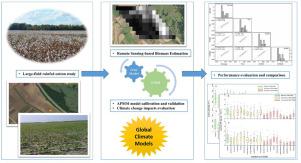Agricultural and Forest Meteorology ( IF 5.6 ) Pub Date : 2022-08-31 , DOI: 10.1016/j.agrformet.2022.109148 Zhou Li , Dorothy Menefee , Xuan Yang , Song Cui , Nithya Rajan

|
Assessing the potential of using process-based models combined with remote sensing and climate change scenarios to understand potential climate change impacts on rainfed cotton (Gossypium hirsutum L.) productivity is crucial for major production areas, such as the East-Central Texas. This study incorporated these methods to study the impacts of future climate on biomass production, crop development, lint yield, and water use efficiency in a Texas rainfed cotton system. Based on two-years of field data obtained from a rainfed cotton field (12 ha), APSIM accurately predicted cotton biomass and lint yield during the calibration (NRMSE: biomass, 17.6%; lint, 10.8%) and validation (NRMSE: biomass, 18.8%; lint, 13.1%) processes. The deviation between simulated and observed development stages as days after sowing was less than 6 days across squaring, flowering, and boll maturity stages. A partial least square model was constructed based on satellite NDVI data and development stage accurately predicted cotton biomass (R2 = 0.93, P < 0.05), and the results agreed well with the predicted values of APSIM (R2 = 0.96, P < 0.05), which was calibrated by the cotton biomass derived from NDVI. Decreased yield was detected in almost all RCP scenarios, with the greater reductions in end-century (29.9–82.4%) scenarios than mid-century (16.2–46.7%) scenarios. For precipitation productivity, 14–80.3% of reduction was found across all future scenarios. A great reduction in reliable yield (45.0–92.0%) and reliable precipitation productivity (37.6–84.7%) were projected by future scenarios. Slight differences were detected in model validation between the two dominant soil types present at the study location; however these differences were much greater under future projections (P < 0.05), largely caused by differences in water holding capacity during critical growth stages. The results from this study suggest that future managerial and breeding efforts that focus on water use efficiency enhancement should be promoted in the future.
中文翻译:

使用 APSIM、气候情景分析和遥感模拟旱地棉花的生产力
评估使用基于过程的模型与遥感和气候变化情景相结合的潜力,以了解气候变化对雨育棉花的潜在影响(Gossypium hirsutumL.) 生产力对于主要产区至关重要,例如德克萨斯州中东部地区。本研究结合这些方法来研究未来气候对德克萨斯州雨育棉花系统中的生物量生产、作物发育、皮棉产量和水分利用效率的影响。根据从雨育棉田(12 公顷)获得的两年田间数据,APSIM 在校准(NRMSE:生物量,17.6%;皮棉,10.8%)和验证(NRMSE:生物量, 18.8%;皮棉,13.1%)过程。在播种后几天,模拟和观察到的发育阶段之间的偏差在开芽、开花和铃成熟阶段小于 6 天。基于卫星 NDVI 数据和发育阶段准确预测棉花生物量 (R2 = 0.93,P < 0.05),结果与APSIM的预测值吻合良好(R2 = 0.96,P < 0.05),由NDVI衍生的棉花生物量校准。在几乎所有 RCP 情景中都检测到产量下降,本世纪末(29.9-82.4%)情景的降幅大于世纪中叶(16.2-46.7%)情景。对于降水生产力,在所有未来情景中都发现了 14-80.3% 的减少。未来情景预计可靠产量(45.0-92.0%)和可靠降水生产力(37.6-84.7%)将大幅下降。在研究地点存在的两种主要土壤类型之间的模型验证中检测到细微差异;然而,在未来的预测下,这些差异要大得多(P < 0.05),主要是由关键生长阶段的持水能力差异引起的。这项研究的结果表明,未来应促进以提高用水效率为重点的管理和育种工作。











































 京公网安备 11010802027423号
京公网安备 11010802027423号